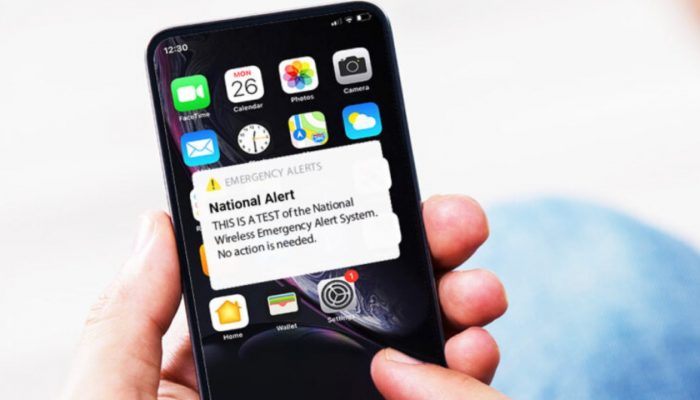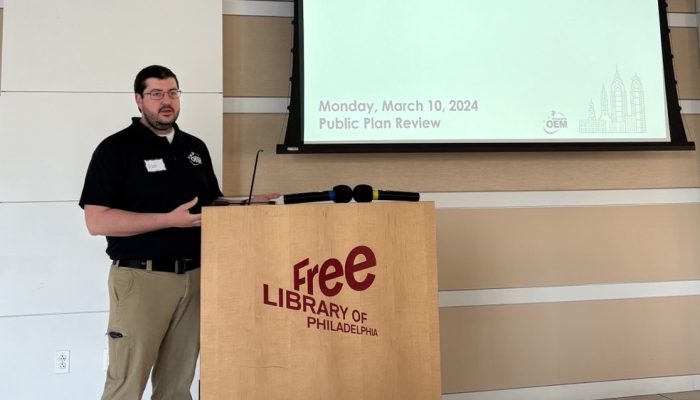VIDEO: Erin Mossup, OEM Alerts and Warning Coordinator, discusses use of emergency alerts
On October 4, the Federal Emergency Management Administration (FEMA), in coordination with the Federal Communications Commission (FCC) will test Wireless Emergency Alerts (WEA) and Emergency Alert System (EAS).
The alerts, scheduled for 2:20 p.m. EST that Wednesday, will send messages to the public through cell phones as well as television and radio broadcasts.
Learn more about FEMA’s test from their press release
Important information
Phone alerts will be sent to WEA-compatible mobile devices of wireless carriers who participate in FEMA’s Integrated Public Alert and Warning System (IPAWS). CTIA, a wireless trade association, publishes lists of WEA-capable phones offered by the largest wireless providers.
A WEA alert appears on the screen of the recipient’s handset as a text-like message. The alert is accompanied by a unique attention signal and vibration, which is particularly helpful to people with hearing or vision-related disabilities.
The EAS portion of the test is scheduled to last approximately one minute. The test message will be similar to the regular monthly EAS test messages with which the public is familiar. It will state: “This is a nationwide test of the Emergency Alert System, issued by the Federal Emergency Management Agency, covering the United States from 14:20 to 14:50 hours ET. This is only a test. No action is required by the public.”
Background
WEA and EAS messages are part of the federal IPAWS program, a national system for local alerting that provides authenticated emergency and life-saving information to the public.
Wireless Emergency Alerts are sent through mobile phones. They can be targeted geographically through cell towers by authorized national, state, or local authorities, like our office, as texts. You may receive a message for a period after it is sent if you travel into a location that has a targeted message or if your phone restarts.
Emergency Alert System information is broadcast to radio, television, and on the National Oceanic and Atmospheric Administration’s Weather Radio.
How We Use It
It’s not just FEMA who can send critical information through the WEA or EAS system. You may think of Amber Alerts for missing children, weather warnings by the National Weather Service, or life safety information sent by us at the Philadelphia Office of Emergency Management.
These messages are reserved for the most emergent situations and only delivered during an urgent situation when a protective action, like an evacuation or shelter-in-place, is needed for a wide area during the most life-safety critical emergencies.
The brief messages will alert you to the issue, direct you to life-safety information, or where to find more facts.
Language Settings
WEA messages are available in English and Spanish currently. To receive messages in Spanish, you must choose your preferred language in your phone’s settings.
Silencing Messages
Participating wireless carriers may offer subscribers with WEA-capable phones the ability to block alerts involving imminent threats to safety of life and/or AMBER Alerts. Consumers cannot block National Alerts.
While it is important to receive credible and critical information from authorities, it also may be important to silence alerts during the test.
According to the Federal Communications Commission, to receive a WEA message, your wireless phone or mobile device must be WEA-capable, switched on, and in the vicinity of and receiving service from a cell tower of a wireless service provider that participates in WEA. You can opt out of receiving WEA messages that are not Presidential messages. To opt out, adjust settings on your mobile device. (Note: wireless subscribers are opted out of State/Local WEA tests by default; to receive State/Local WEA test messages, you must affirmatively opt in.)
If you turn off the vibration or sound on your WEA-capable device, you may not feel the vibration or hear the attention signal of a WEA message.
More information can be found on the FCC’s website.
Not Receiving a WEA?
The FCC says to receive a WEA message, your handset must be WEA-capable, switched on, not on “airplane mode,” and in the vicinity of and receiving service from a cell tower of a wireless carrier that participates in WEA.
Some participating carriers may offer WEA on some, but not all, of their mobile devices. Consumers should check with their wireless carriers to find out if their cell phone is WEA-capable.
Stay Connected
Don’t forget to stay prepared and in the know for times and incidents that don’t need a WEA notification. You can do this by signing up for ReadyPhiladelphia, The City of Philadelphia’s notification system that provides you with emergency information. Simply text ReadyPhila to 888-777 or visit www.phila.gov/ready to customize email or phone alerts.




